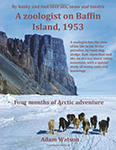I have been interested in the Canadian island of Baffin Island since ‘Frozen Fire: a Tale of Courage‘ by James Houston was a set text when I went to school. Baffin Island, which straddles the Arctic Circle in the Canadian Arctic Archipelago is in many ways the archetypal ‘Arctic’ location – it has sea ice, polar bears, mountains, glaciers, icecaps, icebergs, fjords, the fabled ‘Northwest Passage‘, whales and Eskimos (now of course, known as Inuit). So Adam Watson‘s book, published in 2011, about his journey to Baffin Island sixty years ago as a young man in 1953 has been on my reading list for some time.
This book covers chronologically in detail the events of the summer months of 1953 when Adam Watson was part of a large group of scientists and explorers who undertook an expedition organised by the Arctic Institute of North America to Pangnirtung Fiord and the Weasel and Owl valleys (an area now known as Akshayuk Pass) on Baffin Island, now part of Auyuittuq National Park.
On the other side of the world, Mount Everest was first successfully climbed while this expedition was underway – this was still an era of pioneers and the decade of the 1950s was possibly the last time that groundbreaking exploration like this could be carried out. Auyuittuq Park and the area in which this 1953 expedition travelled contains some incredibly dramatic peaks with the highest vertical mountain faces in the world, including Mount Asgard (which was first climbed on this expedition by members of the expedition team), Mount Odin (the highest mountain on Baffin Island) and Thor Peak. The Weasel and Owl valleys are now a playground for BASE jumpers and climbers but back in 1953 the area was largely unexplored and access was difficult. Adam Watson’s book is thus a remarkable journal of a time when the area was awaiting first ascents and scientific discoveries before large-scale tourism and globalisation changed the area and the Inuit way of life.
Adam Watson’s description of this Inuit lifestyle, just as it was on the cusp of change and still with real links remaining to their past and traditions is one of the highlights of the book, particularly the first section that details Adam Watson’s time on a sledge (qamutiq or komatik) on the sea ice of Padle Fiord and the area around Padloping Island with an Inuit guide and his dogs. Also notable are his observations of the way that previous European visitors to the area had influenced the Inuit population, notably Scottish whalers who had left a legacy of Scottish country dancing that was eagerly adopted by the Inuit!
Anyone who has read Adam Watson’s autobiography of the early decades of his life, ‘It’s a Fine Day for the Hill‘, or anyone who has an interest in the Arctic, will enjoy this book. As in his autobiography, Adam Watson’s writing style is engaging and descriptive; his eye for the details of human personalities and the natural environment around him is sharp and this makes for a compelling read. The very real harshness and danger of the place, but also the wild beauty, are presented expertly by Adam Watson, in a restrained style and without hyperbole, but all the time maintaining excitement – he lets the places, events and people speak for themselves.
Adam Watson also includes much information about the primary purpose of the expedition, which was scientific exploration, research and investigation, and his own particular speciality, which was the animal life of the area, particularly birds. He also makes his contribution to the ‘myth busting’ of the commonly-held belief that lemmings in the Arctic periodically commit suicide en masse (a myth popularised by Disney of course). He also laments the current status of scientific research globally, contrasting it with the aims and approach of the 1953 expedition, and it is also interesting to read his perspective on AGW (Anthropogenic Global Warming) – while he doesn’t go so far as to label this a myth, throughout the book he firmly makes the case for ‘real’ scientific enquiry, fieldwork, quantitative analysis, interdisciplinary collaboration, hypothesis testing and scepticism.
The book also highlights Pat Baird, the expedition organiser and leader, who was an interesting character who deserves to be more widely known. The noted zoologist, Vero Copner Wynne-Edwards, also joined the expedition.
A fantastic view of the area that the expedition travelled in was shown in the 2009 ITV series ‘Journey to the Edge of the World‘ in which Billy Connolly (referred to in the book by Adam Watson, somewhat disparagingly, as a show-business Scot!) was transported by helicopter to the summit of Mount Battle (named after a member of the team who died during the expedition in a drowning accident in a partially-frozen pond, Ben Battle).
Perhaps the most remarkable aspect of this book is the copious collection of photographs from the expedition from Adam Watson’s personal collection – the format of the book allows large full-page images to be shown, many of which are in colour, an unusual and unique record of an area which was little-visited and relatively unrecorded in the 1950s, and certainly not with colour photography.

Leave a Reply